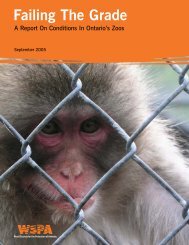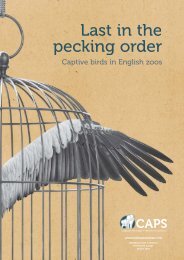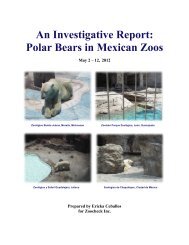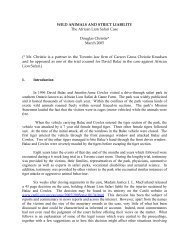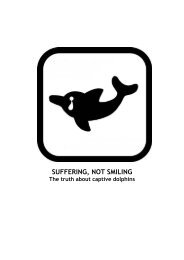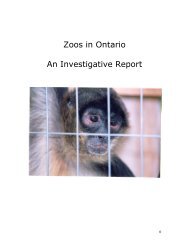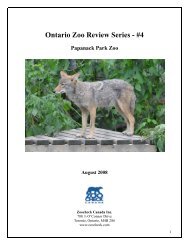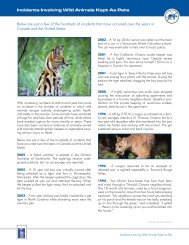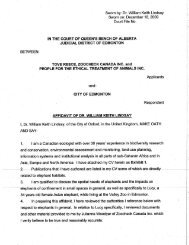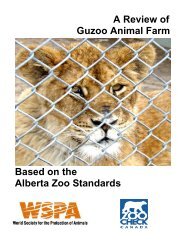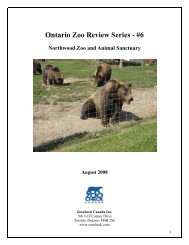STATUS OF BEAR WELFARE
STATUS OF BEAR WELFARE
STATUS OF BEAR WELFARE
You also want an ePaper? Increase the reach of your titles
YUMPU automatically turns print PDFs into web optimized ePapers that Google loves.
Status of Bear Welfare in Cherokee, North Carolina<br />
There were no shelters where a bear could go in inclement weather. Whether or not the bears<br />
were locked out on exhibit for the facility’s hours of operation, the bears had little choice but to be<br />
outside in the pits, even during inclement weather, in order to be fed by the public. None of the<br />
pits were equipped with visual baffles that would allow the bears to remove themselves from the<br />
view of each other.<br />
Santa’s Land<br />
The hollow tree log, metal drum, and overhead canopy structure in the bear cub enclosure did not<br />
offer an appropriate opportunity for retreat during inclement weather and must be replaced by a<br />
barnlike structure. The two adult bears could retreat to a single open-sided alcove, but the alcove<br />
could easily be monopolized by the dominant bear, leaving the other bear with no shelter at all.<br />
Neither enclosure provided the bears with any privacy from public view or the view of each other.<br />
Inadequate Drainage<br />
The wet concrete floors and standing water in the pits at CSBP and CBZ were likely caused by<br />
improper drainage and poor ventilation. Because of the fact that the concrete flooring was either<br />
uneven or entirely level (not angled), water from hosing and rain could be left standing in puddles<br />
where the bears walk and defecate and where food is tossed (photo 5). The water was not<br />
draining away, and it appeared as though the only drying process was evaporation. This may be<br />
a relatively rapid process during hot, sunny summer weather with low humidity, but not at other<br />
times.<br />
Exposure to chronically wet floors can result in slipping and over-hydration of footpads, which can<br />
lead to peeling. Without adequate drainage and air circulation in the pit, the bears’ feet can<br />
remain wet for long periods of time. The very important natural oils in a bear’s paw pads are<br />
sucked out of their skin because of the water and concrete surface. This causes the paw pads to<br />
dry out and crack. In these small confines, bears will inevitably step in fecal material, which can<br />
cause the cracks in their paws to become infected, leading to foot sores. Without veterinary<br />
treatment, these sores can cause severe pain and the infection can spread. Standing water also<br />
provides a breeding ground for bacteria and insects, such as mosquitoes harboring West Nile<br />
Virus, which is active in North Carolina. 4<br />
All bear enclosures must be well drained and provide dry rest areas, preferably multiple sites, for<br />
the bears they confine.<br />
According to information and photographs (photo 6A) posted on EasternBand.com, effluent from<br />
the bear enclosures at CBZ may be flushed directly into the Oconaluftee River. The photos show<br />
what appear to be drainage pipes leading from the pits toward the river; these were not near any<br />
apparent downspouts. CSBP is also situated alongside the river, and a similar photo (photo 6B)<br />
taken by the inspection team shows what appears to be a drainage pipe where effluent from the<br />
bear enclosures that may include raw sewage and bleach washes out into the Oconaluftee River.<br />
Concrete<br />
All bears were housed on concrete, with the exception of the cub enclosure at SL, which was a<br />
hardpan floor surface. Both are inappropriate.<br />
AN INVESTIGATIVE REPORT <strong>OF</strong> CHIEF SAUNOOKE <strong>BEAR</strong> PARK, CHEROKEE <strong>BEAR</strong> ZOO, AND SANTA’S LAND | 22





